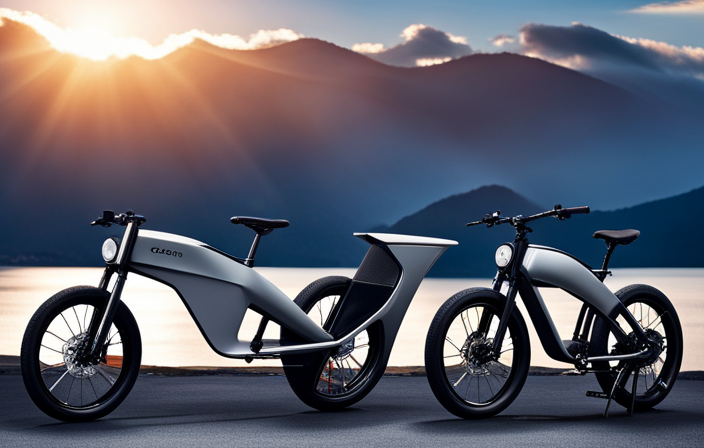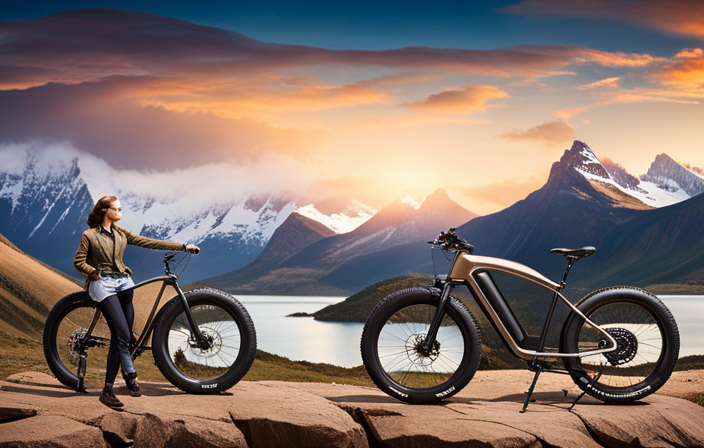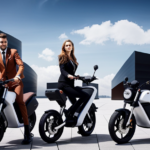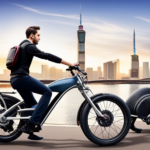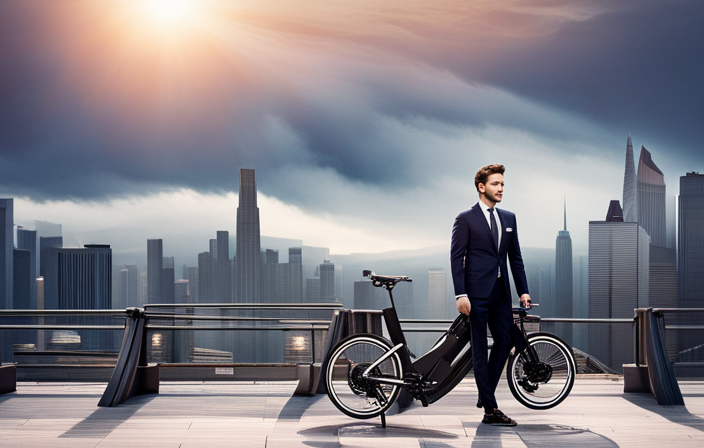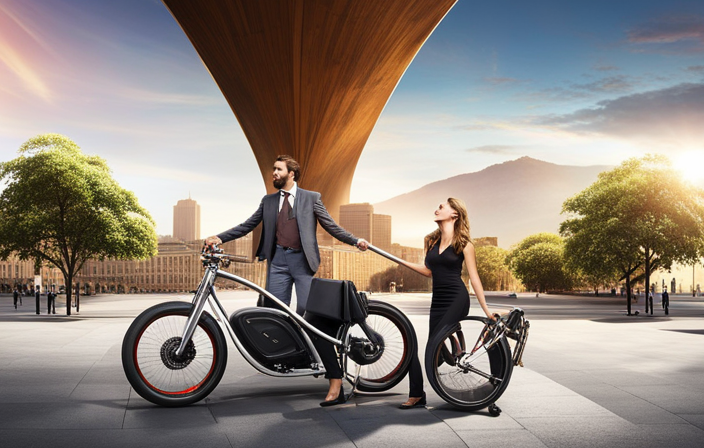Picture yourself driving along the open highway, with the wind in your hair and experiencing the excitement of the journey.
But now, picture yourself doing it on an electric bike instead of a petrol bike.
As the world becomes more conscious of our environmental impact, the choice between electric and petrol bikes has become a hot topic.
In this article, we will delve into the debate, comparing emissions, cost efficiency, performance, and more, to help you determine which is truly the best option for your riding pleasure.
Key Takeaways
- Government incentives and regulations promote the use of electric bikes by offering financial incentives, tax credits, rebates, and subsidies.
- Electric bikes are more sustainable and environmentally friendly with lower energy consumption, reduced carbon emissions, and less noise pollution.
- Resale value and cost analysis should be considered when deciding between electric and petrol bikes, with e-bikes holding their value well in urban settings.
- Electric bikes offer advanced safety features and higher safety levels compared to petrol bikes, supported by objective data from crash tests.
Environmental Impact: Comparing Emissions
The environmental impact of electric bikes is significantly lower than that of petrol bikes. When comparing the emissions of electric and petrol bikes, it becomes clear that electric bikes have a much smaller impact on air quality.
Electric bikes produce zero tailpipe emissions, while petrol bikes emit pollutants such as carbon monoxide, nitrogen oxides, and particulate matter. These pollutants contribute to air pollution and have detrimental effects on human health and the environment.
By choosing an electric bike over a petrol bike, you can help reduce air pollution and improve air quality in your surroundings.
Now, let’s move on to the next section, where we will discuss the cost efficiency of electric bikes compared to petrol bikes in terms of fuel and maintenance expenses.
Cost Efficiency: Fuel and Maintenance Expenses
When comparing the cost efficiency of electric bikes and petrol bikes, it’s important to consider fuel and maintenance expenses. Electric bikes have a significant advantage in terms of fuel economy, as they require only electricity to operate, which is generally cheaper than petrol. This translates into long term savings, especially for those who commute frequently or travel long distances. Additionally, electric bikes tend to have lower maintenance costs compared to petrol bikes. They have fewer moving parts and don’t require regular oil changes or tune-ups. This means less money spent on maintenance and repairs over time. To illustrate the cost efficiency comparison between electric bikes and petrol bikes, refer to the table below:
| Electric Bikes | Petrol Bikes | |
|---|---|---|
| Fuel Cost | Low | High |
| Maintenance Cost | Low | High |
| Long Term Savings | High | Low |
With their lower fuel and maintenance expenses, electric bikes offer a more cost-effective option in the long run. Now let’s delve into the subsequent section about performance: speed and acceleration.
Performance: Speed and Acceleration
If you’re looking for a thrilling ride, speed and acceleration are important factors to consider. When comparing electric bikes and petrol bikes in terms of performance, it’s essential to understand the differences between speed and torque.
Petrol bikes are known for their high speeds and quick acceleration due to their powerful engines. On the other hand, electric bikes may not match the top speeds of petrol bikes, but their torque delivery is instantaneous, providing quick acceleration off the line.
Additionally, electric bikes are more energy-efficient compared to petrol bikes, as they convert a higher percentage of energy into forward motion. However, this energy efficiency comes at the cost of power consumption.
Transitioning into the subsequent section about ‘range and battery life,’ it’s crucial to consider the impact of speed and acceleration on an electric bike’s range and battery life.
Range and Battery Life
For longer rides, you’ll want to consider the range and battery life of your chosen ride. Electric bikes have made significant advancements in battery technology over the years, allowing them to offer impressive ranges. Depending on the model and riding conditions, electric bikes can typically provide a range of 40 to 100 miles on a single charge. This range can vary based on factors such as rider weight, terrain, and speed.
However, it’s important to note that electric bikes do have limited battery life, and once the battery is depleted, the bike will need to be recharged. Charging times can vary from a few hours to overnight, depending on the battery capacity and the charger used.
In the next section on charging infrastructure, we will explore the availability and convenience of charging stations for electric bikes.
Charging Infrastructure
To ensure a smooth and convenient charging experience, you’ll want to consider the availability and accessibility of charging stations for your electric ride. Electric bike charging stations are becoming increasingly common, with more and more locations offering this service. This means that you’ll have plenty of options when it comes to finding a place to charge your electric bike.
Additionally, the impact on the power grid is minimal, as electric bikes consume much less energy compared to petrol bikes. This not only reduces the strain on the grid but also helps in reducing carbon emissions. So, when it comes to charging your electric bike, you can rest assured knowing that the infrastructure is steadily improving and becoming more widespread.
Moving on to the next section about noise levels, let’s explore how electric bikes fare in this aspect.
Noise Levels
When it comes to noise levels, you’ll be pleased to know that electric bikes offer a quieter and more peaceful riding experience. Unlike petrol bikes, which can produce loud engine noises, electric bikes operate almost silently. This not only reduces sound pollution in the environment but also has a positive impact on your health. Excessive noise can lead to stress, hearing loss, and other health issues. By choosing an electric bike, you can enjoy a smoother and quieter ride, minimizing the negative effects of sound pollution on your well-being. In fact, studies have shown that noise reduction can have significant benefits for both physical and mental health. Now, let’s transition into the next section and explore the ease of use and handling of electric bikes.
Ease of Use and Handling
Get ready for an effortless and smooth ride with the easy handling of an electric bike. Electric bikes are designed with comfort and maneuverability in mind, allowing you to enjoy a hassle-free experience on the road.
The user-friendly technology of electric bikes makes them a breeze to operate, with features like pedal-assist and throttle control providing extra support and ease of use. Whether you’re navigating through traffic or cruising along scenic routes, electric bikes offer a comfortable and enjoyable ride.
Now, let’s transition into the next section about maintenance requirements and explore how electric bikes require less upkeep compared to petrol bikes.
Maintenance Requirements
Now that we have discussed the ease of use and handling of electric bikes versus petrol bikes, let’s delve into the maintenance requirements.
When it comes to maintenance costs, electric bikes have a clear advantage over petrol bikes. Electric bikes have fewer moving parts, which means there are fewer components that can break or wear out. This translates to lower maintenance costs in the long run.
Additionally, electric bikes tend to be more durable and reliable compared to their petrol counterparts. They don’t require oil changes, spark plug replacements, or other regular maintenance tasks associated with petrol bikes. This makes electric bikes a hassle-free option for those who prefer a low-maintenance ride.
Moving forward to the next section about availability and accessibility, it’s important to consider the options for acquiring these bikes without any inconvenience.
Availability and Accessibility
To easily find and access an electric bike, you can explore various rental and purchase options. However, availability challenges still exist in some areas. While electric bikes are becoming more popular, they may not be as readily available as their petrol counterparts. This is due to the fact that electric bikes are still a relatively new technology and may not be as widely stocked by retailers.
Additionally, accessibility for different demographics can also be a concern. Electric bikes may be more expensive upfront, which can limit access for individuals with lower incomes. Furthermore, some individuals may not have access to charging stations or the ability to charge the bike at home, which can also hinder accessibility.
Despite these challenges, government incentives and regulations are being put in place to promote the adoption of electric bikes. Transitioning into the subsequent section, these incentives and regulations aim to encourage the use of electric bikes and overcome availability and accessibility barriers.
Government Incentives and Regulations
Government incentives and regulations are being implemented to encourage the use of e-bikes and address availability and accessibility challenges. Many governments around the world are recognizing the potential benefits of electric bikes and are offering financial incentives to individuals and businesses to switch from petrol bikes. These incentives can include tax credits, rebates, or subsidies on the purchase of e-bikes.
Additionally, governments are also working on creating a regulatory framework that promotes the use of e-bikes while ensuring safety and environmental standards are met. By implementing these measures, governments aim to increase the availability and accessibility of e-bikes, making them a viable alternative to petrol bikes.
This shift towards e-bikes is crucial for long-term sustainability and reducing emissions from the transportation sector.
Now, let’s delve into the next section about the long-term sustainability of electric bikes.
Long-Term Sustainability
When considering long-term sustainability, it is important to evaluate the environmental impact and longevity of e-bikes. Electric bikes have a significantly lower energy consumption compared to petrol bikes, making them a more environmentally friendly option. Additionally, e-bikes have lower long-term cost analysis due to their lower maintenance and fuel costs.
Here are a few bullet points to emphasize the benefits of electric bikes:
- Reduced carbon emissions, leading to cleaner air and a healthier planet
- Lower noise pollution, creating a more peaceful and enjoyable riding experience
- Increased energy efficiency, ensuring optimal use of resources
- Less dependence on fossil fuels, contributing to a more sustainable energy future
Taking all these factors into consideration, it is clear that electric bikes offer a more sustainable alternative to petrol bikes.
Now, let’s explore the next section on ‘resale value’.
Resale Value
Considering the resale value of e-bikes, you’ll find that they hold their value well and can be a smart investment for the future.
When comparing the resale value in urban and rural areas, it is worth noting that e-bikes tend to maintain a higher value in urban settings. The demand for electric bikes in cities is higher due to their eco-friendly nature and the convenience they provide in congested areas. On the other hand, petrol bikes may have a higher resale value in rural areas where access to charging infrastructure for electric bikes might be limited.
Additionally, the impact of technological advancements plays a significant role in the resale value of both electric and petrol bikes. As electric bike technology continues to improve, their resale value is likely to increase.
Transitioning into the subsequent section about safety features and crash tests, it is essential to consider these factors when making a decision between electric and petrol bikes.
Safety Features and Crash Tests
When it comes to comparing electric bikes and petrol bikes, safety features and crash tests are an important aspect to consider. Electric bikes have made significant advancements in terms of safety features, with many models incorporating advanced technologies such as anti-lock braking systems (ABS), traction control, and stability control. These features not only enhance the safety of the rider but also contribute to the overall crashworthiness of the bike. Crash tests conducted by independent organizations provide safety ratings for both electric and petrol bikes, allowing consumers to make informed decisions based on objective data. To evoke an emotional response, consider the following table:
| Electric Bikes | Petrol Bikes |
|---|---|
| ABS | No ABS |
| Traction Control | Limited Control |
| Stability Control | No Stability Control |
Considering these safety features and crashworthiness ratings, it is clear that electric bikes offer a higher level of safety. Moving forward, let’s explore the customization options available for both types of bikes.
Customization Options
Moving forward, let’s explore the range of customization options available for both types of bikes. When it comes to customizing your electric or petrol bike, the possibilities are endless. Here are some key customization options to consider:
-
Custom paint: Give your bike a unique look by choosing a custom paint job that reflects your personal style. Whether you prefer bold and vibrant colors or a sleek and understated design, custom paint allows you to make your bike stand out from the crowd.
-
Aftermarket accessories: Enhance your riding experience with a wide range of aftermarket accessories. From upgraded seats and handlebars to performance-enhancing parts, these accessories allow you to tailor your bike to your specific needs and preferences.
-
Personalized decals and graphics: Add a personal touch to your bike with custom decals and graphics. Whether you want to display your favorite sports team logo or showcase your own design, decals and graphics can transform your bike into a true reflection of your personality.
Moving on to the next section about personal preferences and riding experience, let’s discuss how these customization options can impact your overall enjoyment of the bike.
Personal Preferences and Riding Experience
To truly personalize your ride, it’s important to take into account your own preferences and how they can impact your overall experience on the road.
When it comes to choosing between an electric bike and a petrol bike, personal preferences play a significant role. Some riders prefer the traditional feel and sound of a petrol bike, while others enjoy the quiet and smoothness of an electric bike.
If you value a more eco-friendly option and want to reduce your carbon footprint, then an electric bike might be the better choice for you. On the other hand, if you prioritize power and speed, a petrol bike might be more suitable.
Additionally, riding comfort is another aspect to consider. Electric bikes tend to have a more relaxed and comfortable riding position, while petrol bikes offer a more aggressive and sporty stance.
Ultimately, your personal preferences and riding comfort should guide your decision.
Frequently Asked Questions
Are there any government incentives or regulations in place to encourage the use of electric bikes?
Yes, there are government incentives and regulations in place to encourage the use of electric bikes. Many countries offer tax credits or subsidies for purchasing an electric bike, making them more affordable.
In addition, some cities have implemented policies such as dedicated bike lanes and charging stations to support electric bike popularity. These incentives and regulations aim to reduce carbon emissions, promote sustainable transportation options, and improve air quality in urban areas.
How do electric bikes compare to petrol bikes in terms of long-term sustainability?
In terms of long-term sustainability, electric bikes have several advantages over petrol bikes.
Electric bike efficiency is significantly higher, as they convert a higher percentage of energy into motion compared to petrol bikes.
Additionally, electric bikes have a lower environmental impact compared to petrol bikes, as they produce zero emissions during operation.
These factors make electric bikes a more sustainable choice for transportation, contributing to a greener and cleaner future.
What are the resale values of electric bikes compared to petrol bikes?
When comparing the resale values of electric bikes and petrol bikes, it is important to consider market trends.
Currently, electric bikes tend to have lower resale values compared to petrol bikes. This can be attributed to factors such as limited demand, rapid advancements in technology, and concerns about battery degradation.
However, as the market for electric bikes continues to grow and technology improves, it is possible that resale values will increase in the future.
Can electric bikes be customized to suit personal preferences?
Yes, electric bikes can be customized to suit your personal preferences. From choosing the color and design to adding accessories like racks or baskets, there are various options available.
Additionally, you can also customize the performance aspects such as the motor power or battery capacity to align with your specific needs.
Electric bike customization allows you to create a unique and personalized riding experience that caters to your individual style and requirements.
How does the riding experience differ between electric bikes and petrol bikes?
The riding experience between electric bikes and petrol bikes differs in terms of riding comfort and environmental impact.
Electric bikes provide a smoother and quieter ride due to their lack of engine noise and vibrations. They also offer instant torque, making acceleration more responsive. Additionally, electric bikes have a lower environmental impact as they produce zero emissions.
Petrol bikes, on the other hand, may offer a more traditional experience but contribute to air pollution and noise pollution.
Conclusion
In conclusion, after analyzing the various factors, it is clear that the electric bike is the better option.
Not only does it have a lower environmental impact with zero emissions, but it also proves to be more cost-effective in terms of fuel and maintenance expenses.
Moreover, the electric bike offers a smooth and silent riding experience, with excellent acceleration and range.
With the growing charging infrastructure and the potential for customization, it is like having a futuristic vehicle at your disposal.
So, why settle for a petrol bike when you can embrace the eco-friendly and efficient electric bike?
It’s a ride that takes you into the future.
